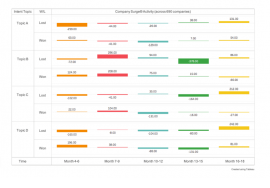Bombora now shows clients online content interests that led to a purchase


Bombora provides B2B marketers with data about which companies are ready to buy their products. They develop those insights by tracking the content interests of personnel at the target companies, such as when they download a white paper on servers and then visit a web page about servers.
On Monday, the New York City-based firm is offering a new product, called the Historical Buyer Journey Analysis Tool. After a purchase has been made, it looks at the previous 18-month breadcrumb trail of content consumption leading to a purchase.
Interest scores over 18 months. One of Bombora’s client companies provides it with a list of purchases by specific customer companies, and Bombora then looks at data trails for those customers over the last 18 months to determine which topics the company’s personnel looked at, and when.
Additionally, it assigns a score for each topic that indicates the apparent change of interest by the customer company in that topic, compared to a control group of companies of about the same size, in the same industry.
Here’s a screen showing the kind of interest progressions across topics, comparing a group of buyers to a group that was in the pipeline but failed to buy:
4000 topics across 3500 websites. Bombora tracks levels of interest in approximately 4000 topics across about 3500 B2B websites, as determined by such signals as the content of web page visits or webinar signups.
The data on what online content was downloaded or viewed by company personnel on their way to a purchase had previously been available in the company’s main offering, Company Surge, where levels of interest in related online topics are used to predict when a company is in-market for a product.
At one point, Director of Data Science Nicholaus Halecky told me, a major, unnamed client asked Bombora for more detail on the topics, as well as information on how the degree of interest in those topics changed over time, for companies that made a purchase. This request encouraged Bombora to now release that data as a separate product, allowing B2B marketers to look back to the historical trail in addition to looking ahead for a prediction.
This new product is the latest step by Bombora to open up its data to clients. In 2016, the company made its Surge data available to clients via a self-service dashboard.
Different kinds of research in different parts of the journey. Halecky said his company doesn’t yet have any data on the degree of accuracy for this historical trail, on whether it leads to more sales/leads or on whether it might improve marketers’ ability to predict the customer journey.
But one of Bombora’s client companies, Juniper Networks, said in a statement that this data can offer useful insights into customer progression.
“We found that customers researched broad topics earlier in the journey,” Senior Manager Leila Schwarz said, “progressing later into more solution-focused and product-specific topics.”
Bombora’s new Historical Analysis is also accompanied by a new Audience Verification, which shows which target companies are seeing a brand’s ads, and in which channels.
Why you should care. While Bombora and many other data analytics providers offer their predictions about which companies are most likely to become customers for a given brand’s products, the new Historical Analysis taps into known use cases: actual customers who made purchases.
This is part of a general trend by marketers to find growth drivers by seeing what has worked, via the analysis of successful customer journeys. In other words, there are still ways to better understand how to convince new customers by better understanding what got existing customers to sign up.
This story first appeared on MarTech Today. For more on marketing technology, click here.
The post Bombora now shows clients online content interests that led to a purchase appeared first on Marketing Land.
From our sponsors: Bombora now shows clients online content interests that led to a purchase



